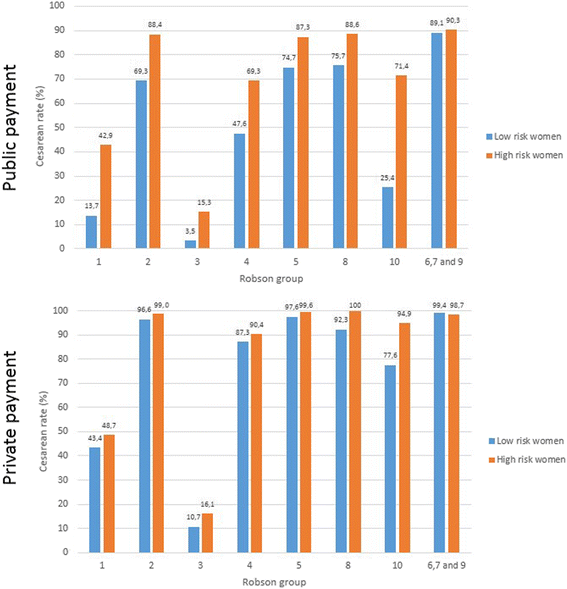Use of Robson classification to assess cesarean section rate in Brazil: the role of source of payment for childbirth
- PMID: 27766941
- PMCID: PMC5073850
- DOI: 10.1186/s12978-016-0228-7
Use of Robson classification to assess cesarean section rate in Brazil: the role of source of payment for childbirth
Abstract
Background: Cesarean section (CS) rates are increasing worldwide but there is some concern with this trend because of potential maternal and perinatal risks. The Robson classification is the standard method to monitor and compare CS rates. Our objective was to analyze CS rates in Brazil according to source of payment for childbirth (public or private) using the Robson classification.
Methods: Data are from the 2011-2012 "Birth in Brazil" study, which used a national hospital-based sample of 23,940 women. We categorized all women into Robson groups and reported the relative size of each Robson group, the CS rate in each group and the absolute and relative contributions made by each to the overall CS rate. Differences were analyzed through chi-square and Z-test with a significance level of < 0.05.
Results: The overall CS rate in Brazil was 51.9 % (42.9 % in the public and 87.9 % in the private health sector). The Robson groups with the highest impact on Brazil's CS rate in both public and private sectors were group 2 (nulliparous, term, cephalic with induced or cesarean delivery before labor), group 5 (multiparous, term, cephalic presentation and previous cesarean section) and group 10 (cephalic preterm pregnancies), which accounted for more than 70 % of CS carried out in the country. High-risk women had significantly greater CS rates compared with low-risk women in almost all Robson groups in the public sector only.
Conclusions: Public policies should be directed at reducing CS in nulliparous women, particularly by reducing the number of elective CS in these women, and encouraging vaginal birth after cesarean to reduce repeat CS in multiparous women.
Keywords: Brazil; Cesarean section; Health systems; Robson classification.
Figures

References
-
- World Health Organization. WHO statement on caesarean section rates. 2015. http://apps.who.int/iris/bitstream/10665/161442/1/WHO_RHR_15.02_eng.pdf?.... Accessed 14 June 2015.
-
- Souza JP, Gülmezoglu A, Lumbiganon P, Laopaiboon M, Carroli G, Fawole B, et al. Caesarean section without medical indications is associated with an increased risk of adverse short-term maternal outcomes: the 2004–2008 WHO Global Survey on Maternal and Perinatal Health. BMC Med. 2010;8:71. doi: 10.1186/1741-7015-8-71. - DOI - PMC - PubMed
MeSH terms
LinkOut - more resources
Full Text Sources
Other Literature Sources
Medical

